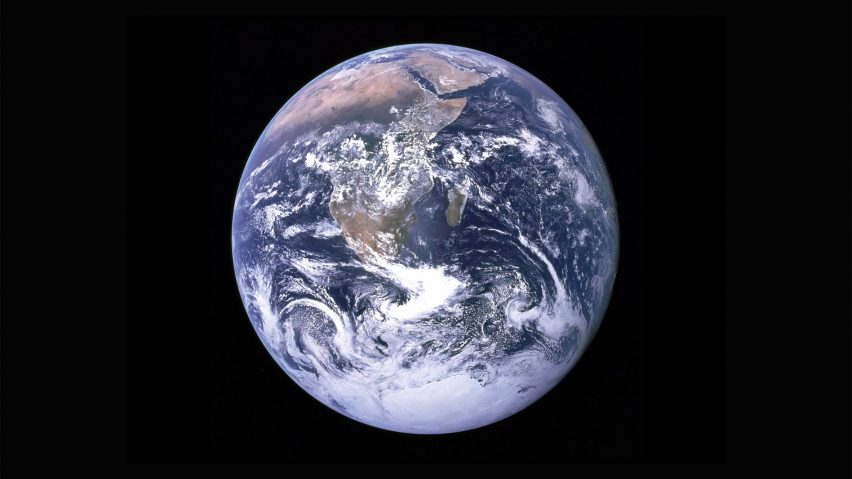Today is Earth Overshoot Day, marking the date when humanity's consumption of resources exceeds the planet's annual capacity to regenerate them. It should serve as a reminder for designers to take the lead in building a more sustainable future, writes Sian Sutherland.
Earth Overshoot Day falls on 2 August this year and represents the the day that, as a planet, we have used up our annual share of resources that nature can replenish in a year.
It's a day that misleads many and hides an unequal truth, because Earth Overshoot for UAE, USA and Canada is not in August, it's 13 March. For the UK, 15 May. Compare that with Cuba, Iraq, Colombia, Egypt – all in November. Only three countries restrain themselves from taking more than the planet can sustain: Indonesia, Ecuador and Jamaica.
We are out of sync and we need to change, before change is forced upon us
In our pursuit of never-ending growth we imagine that nature's resources are limitless, that they are rightfully ours to take, with scant consideration of the consequences. By the mid-21st century, we are forecast to be taking four times the safe level of resources.
And what do we give back? Billions of tonnes of toxic complex waste, damaging the very ecosystem that feeds us, destroying the delicate balance of biodiversity that sustains our living systems, feeding us, clothing us, giving us the lives we strive for.
Imagine if we used our extraordinary creativity to change these living systems. To reset our needs state and, dare I say it, to challenge that our version of capitalism is not actually working. There is a reason the global mental-health crisis is happening at the same time as the climate crisis. We are out of sync and we need to change, before change is forced upon us.
There is nothing wrong with growth. Everything alive grows. But consider this: everything grows to a certain size, a certain life stage, reaching an optimum level of being before reaching the end of its life and returning to nature as the nutrient for the next stage of living growth. Nothing grows forever. It's the one true circular model.
A powerful shift in thinking is happening, like Kate Raworth's Doughnut Economics model that guides us to keep within the constraints of the "Doughnut Ring", thriving whilst maintaining planetary and societal boundaries.
We are witnessing seismic shifts in material creation, simply borrowing from nature's nutrient cycle, minimising chemical modification so everything we make can return to nature safely. New models that eradicate single use, giving us products of permanence instead of branded trash.
Never has mankind and the way we live been positively influenced by a banker
But progress is slow. Homos Economicus is largely ignoring such common sense opportunities, clinging to the 200-year-old principles that have brought us to this precipitous place.
We now live in a time no longer of climate warming but of climate burning. The fossil-fuel industry has become both our life support and planetary death sentence. Petrochemicals, in the forms of plastics, resins, coatings, paints, wood compounds, surround us daily.
And when, as we are witnessing in Europe, Canada and beyond, the fires spark and rapidly become devouring furnaces, the man-made petro-materials are the ultimate accelerant fuel. A deadly gift given twice.
What will it take? When will we truly act as one human body to step onto a very different road? I believe this is a time we need to listen to a very different audience. The financiers have had a monopoly on opinion, and yet never has mankind and the way we live been positively influenced by a banker.
No, now is the time for the creative industry at large – the engineers, the architects, the designers, the entrepreneurs – to rise up and grab the reins. Only the creative industries have the visionary capacity to build a picture of a very different future for us all. A bright and exciting future we can accelerate towards with optimism.
How we live today will be very different from how we live tomorrow. Speaking recently to David Chipperfield, he explained to me how people were confused that his extraordinary Galician project includes seaweed farms. "But you're an architect," they challenged. "What do seaweed farms have to do with buildings?" His answer was simple. "If we are building a new city of the future, we need to have the jobs of the future or we will have no young people living there."
We urge every creative talent globally to take this day as a date to create what's next
For sure, designers are going to need some new tools to help create this different way of living for all of us. We created PlasticFree to be one of those essential tools, igniting, empowering, inspiring, educating on the new materials and systems we must urgently embrace.
Symbolically, we are today showing some of those new materials on the world's most famous digital billboard: the Nasdaq screen in Times Square, as well as billboards across the UK. The message is simple – positive proof on the day we run out of resources that we do not need to wait for some distant innovation before we design differently.
The future is here now. We urge every creative talent globally to take this day as a date to create what's next, the moment to lead us not into climate disaster, but into a brave and powerfully exciting movement to use their brilliant skills for good. Because everything begins with design. Everything begins with you. Never have we needed you more.
Sian Sutherland is co-founder and chief changemaker at PlasticFree and A Plastic Planet.
The photo is by NASA.
Dezeen In Depth
If you enjoy reading Dezeen's interviews, opinions and features, subscribe to Dezeen In Depth. Sent on the last Friday of each month, this newsletter provides a single place to read about the design and architecture stories behind the headlines.

